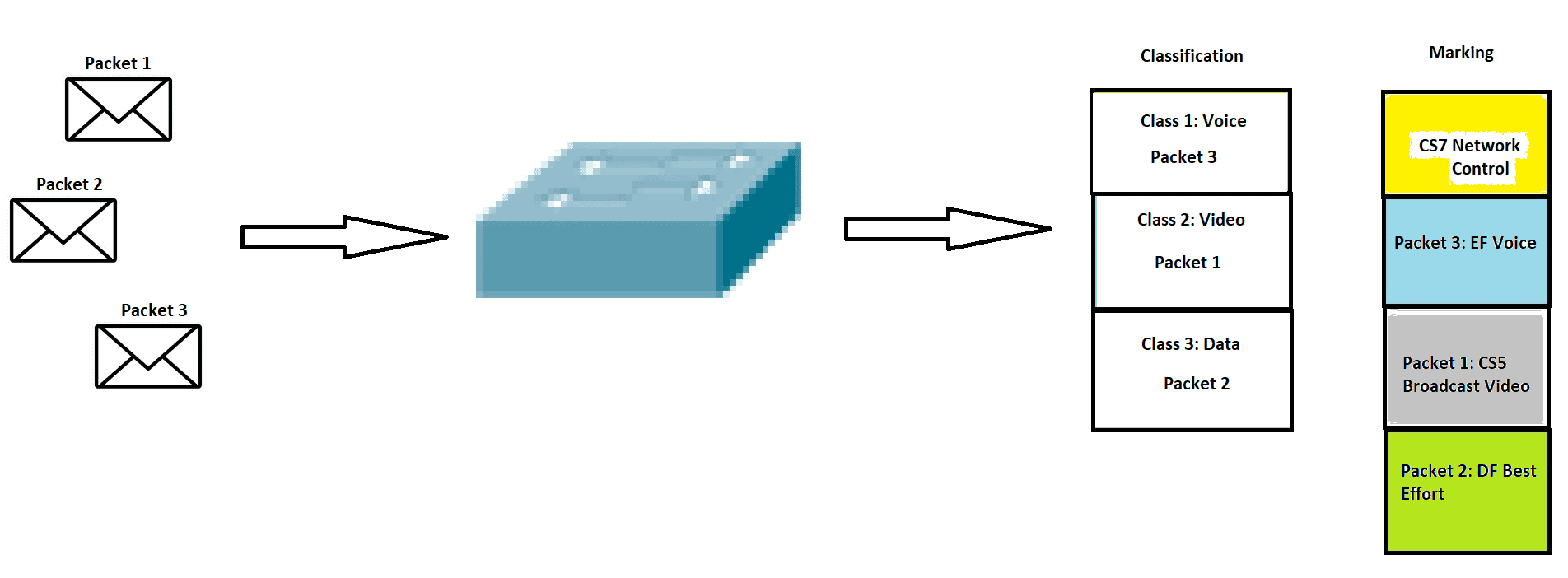Quality of Service (QoS) is a mechanism or technology that handles network traffic and allocates capacity to ensure the performance of critical applications. All QoS mechanisms are designed to resolve or reduce bandwidth overutilization, delay, flapping, and packet loss in a network. Some of the QoS tools are Classification and Marking, Queuing, Policing and Traffic Shaping, and Congestion Management.
QoS Classification
Before we can configure any QoS tools, like queuing, policing, or shaping, we have to look at the traffic that is coursing through our network device and identify it first. QoS classification refers to the process of classifying the type of IP packets or traffic. Traffic types can be data, video, or voice traffic. Traffic classes are the categories of traffic that are grouped based on their similarity.
Traffic Descriptors
QoS classification usually uses traffic descriptors as criteria, which include:
- Internal – QoS group
- Layer 1 – Physical interface
- Layer 2 – 802.1Q/p Class of Service (CoS) bits and MAC addresses
- Layer 2.5 – MPLS Experimental (EXP) bits
- Layer 3 – Differentiated Services Code Point (DSCP) value, IP Precedence value (IPP), and source and destination IP addresses
- Layer 4 – TCP and UDP ports
- Layer 7 – Next Generation Network-Based Application Recognition (NBAR2)
NBAR2 is a deep packet inspection tool used to classify and recognize a wide range of protocols and applications utilizing data from Layer 3 to Layer 7, including applications that dynamically assign TCP and UDP port numbers.
NBAR2 has two modes of operation, which are:
- Protocol Discovery – identifies and obtains real-time statistics on applications currently operating in the network. These statistics can specify QoS classes and policies using MQC configuration.
- Modular QoS CLI (MQC) – a network traffic that matches a certain network protocol can be classified into one traffic class, whereas another traffic that matches a different network protocol can be placed into a different traffic class. Different QoS policies can be applied to the various traffic classes after classification.
Here are the CoS values (layer 2 header) and their applications:
| CoS | Application |
| 7 | Network Control |
| 6 | Internetwork Control |
| 5 | Voice |
| 4 | Video |
| 3 | Call Signaling |
| 2 | Transactional Data |
| 1 | Bulk Data |
| 0 | Best Effort |
QoS Marking
After classification of IP packet headers based on their contents, QoS Marking includes setting some bits inside a data link or network layer header, with the intention of letting other devices’ QoS tools classify traffic based on the marked values.
Marking can be done at different levels like Ethernet header (layer 2), MPLS label (layer 2.5), IP packet header (layer 3), Network Based Application Recognition (NBAR), and deep packet inspection (layer 7).
In other WAN technologies, we can use single-bit fields in Frame Relay and ATM networks to mark a frame for Layer 2 QoS. Frame Relay determines the discard eligibility (DE) bit setting, and ATM defines the cell loss priority (CLP) bit.
DSCP is the more preferred QoS tool because the router can quickly get information from a single byte on the IP header. Also, the IP header doesn’t change between source and destination addresses.
Here are the DSCP values (layer 3 header) and their equivalent applications:
| DSCP Value | Application |
| CS7 | Network Control |
| CS6 | Internetwork Control |
| EF | Voice |
| CS5 | Broadcast Video |
| AF4 | Multimedia Conferencing |
| CS4 | Realtime Interactive |
| AF3 | Multimedia Streaming |
| CS3 | Signaling |
| AF2 | Transactional Data |
| CS2 | OAM |
| AF1 | Bulk Data |
| CS1 | Scavenger |
| DF | Best Effort |
QoS Trust Boundary
The idea behind the QoS trust boundary is to avoid end devices manipulating traffic prioritization. Once we include a network device in the QoS trust boundary (preferably at the access layer), there’s no need to remark any packets, and this network device will handle QoS marking.
Download our Free CCNA Study Guide PDF for complete notes on all the CCNA 200-301 exam topics in one book.
We recommend the Cisco CCNA Gold Bootcamp as your main CCNA training course. It’s the highest rated Cisco course online with an average rating of 4.8 from over 30,000 public reviews and is the gold standard in CCNA training:
